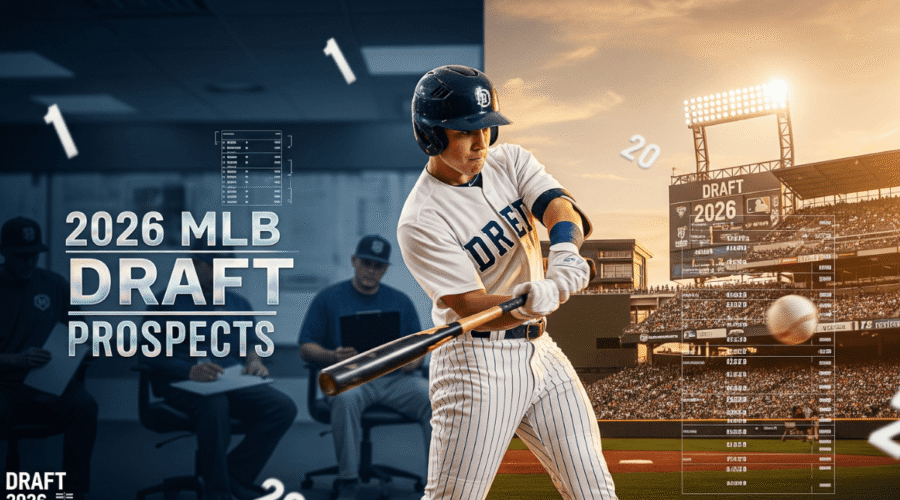2026 MLB Draft Prospects Rankings & Predictions: Early Rumors & Mock Draft Insights
Unlock your insider edge: while the 2025 Draft just wrapped up, professional scouts and talent evaluators are already buzzing about the Class of 2026. From high school summer showcases to the Cape Cod League, the “way-too-early mock draft” is taking shape—and we’ve compiled the top 20 names you need to know right now.
The Scouting Never Stops
How long should we wait to start thinking about the Class of 2026? How does now sound?
The scouting industry hasn’t paused—high school summer showcases and wood-bat college leagues have been under the radar for months. While rankings will evolve between today and July 2026, this is your first comprehensive look at a top-20 early mock draft, packed with predictions and rumors that are already circulating in professional scouting circles.
The excitement surrounding next year’s draft class is palpable, and for good reason. Early predictions suggest this could be one of the deepest classes in recent memory, featuring elite college performers, high-ceiling prep shortstops, and velocity-driven pitching that aligns perfectly with modern MLB priorities.
Read more: 2026 MLB Hall of Fame Ballot: Predictions and Rumors as Baseball’s Elite Chase Cooperstown Glory
Mock Draft Predictions for 2026
Here’s our comprehensive breakdown of the prospects generating the most buzz among scouts and front office executives:
The Elite Tier (Picks 1-5)
1. Roch Cholowsky, SS, UCLA – The undisputed leader in early 2026 predictions, Cholowsky’s lockdown defense pairs with a breakout bat that earned him All-American honors. His .353/.480/.710 slash line with 23 homers as a sophomore has scouts salivating over his two-way star potential.
2. Jacob Lombard, SS, Gulliver Prep (FL) HS – Son of former pro George Lombard, this prep standout combines double-plus speed with a polished right-handed swing. Rumors suggest he’s the most pro-ready high school shortstop in the class.
3. Justin Lebron, SS, Alabama – After posting a .338/.429/.546 freshman campaign and following up with 18 homers as a sophomore, Lebron’s combination of bat, arm, and defensive polish makes him a consensus top-five prospect in early predictions.
4. Grady Emerson, SS, Argyle (TX) HS – The Texas commit surprised scouts with his runner-up finish in the High School Home Run Derby, showcasing latent power in what was previously viewed as a hit-first profile.
5. Gio Rojas, LHP, Marjory Stoneman Douglas HS – This Florida prep southpaw brings a lively fastball that touches 95 mph, complemented by a sharp breaking ball and developing changeup that scouts believe can carry him to mid-rotation ceiling.
The Impact Players (Picks 6-10)
6. Derek Curiel, OF, LSU – His freshman season (.345/.470/.519) highlighted prodigious plate discipline, walking nearly as many times as he struck out. Add developing center field tools, and you have a near-automatic future starter.
7. Drew Burress, OF, Georgia Tech – Don’t let the 5’9″ frame fool you—Burress’s .333/.469/.693 slash with 19 homers and 10 steals showcases advanced bat strength and center field impact potential.
8. Liam Peterson, RHP, Florida – This Gator brings triple-digit heat with a fastball up to 99 mph, complemented by a plus mid-80s slider and developing changeup that has scouts buzzing about strikeout upside.
9. AJ Gracia, OF, Virginia – The 6’3″ lefty bat bounced back from a slow start to belt 15 homers while maintaining excellent plate discipline—exactly what scouts want to see in a potential leadoff center fielder.
10. Cameron Flukey, RHP, Coastal Carolina – This 6’6″ right-hander dominated College World Series showcases with a 98 mph fastball and a devastating arsenal that includes an upper-70s curveball and low-80s slider.
read more: MLB 2026 Schedule Release Date: Predictions and Rumors Surrounding the Delayed Announcement
The Sleepers and Risers (Picks 11-20)
The back half of our top 20 features intriguing prospects with significant upside potential:
- Savion Sims, RHP, Edmond Santa Fe (OK) HS – Standing 6’8″ with a triple-digit heater, this prep pitcher is working on delivery repeatability that could unlock massive potential.
- Tyler Spangler, SS, De La Salle (CA) HS – A 6’3″ left-handed hitting shortstop with advanced barrel skills and plus arm strength.
- Chris Hacopian, SS, Texas A&M – Two-year production (.347/.465/.614 with 29 homers) makes him a run-producing middle infielder, though he may project to third base.
- Brady Harris, OF, Trinity Christian (FL) HS – Smooth right-handed swing with plus speed and gap-to-gap power projection.
Current Trends Shaping 2026 Draft Predictions
Prep Shortstops Dominating Early Rankings
One of the most striking trends in early 2026 predictions is the dominance of prep shortstops. With Cholowsky, Lombard, Lebron, Emerson, and Spangler all projected in the top 12, this class mirrors 2025’s heavy middle-infield emphasis. Scouts are particularly excited about the defensive versatility and athleticism these prospects bring.
Velocity Arms Creating Buzz
The rumor mill is heating up around pitchers who can bring serious heat. From Sims’s triple-digit fastball to Peterson’s 99 mph heater, velocity continues to drive early predictions and scout conversations. The emphasis on “stuff over polish” remains a defining characteristic of modern draft strategy.
Two-Way Prospects Gaining Traction
Players like Cole Koeninger (SS/RHP with dual upside) and Kevin Roberts (OF/RHP with 6’5″ athleticism) are generating increased interest. The success of two-way stars like Shohei Ohtani has MLB teams more willing to let prospects develop multiple skills.
Transfer Portal Impact
The college transfer portal continues to shake up predictions, with players like Joey Volchko (Stanford transfer) and others using portal moves to boost their draft stock. Scouts are closely monitoring how these transfers perform in new environments.
Deep Dive: Top Prospects Analysis
Roch Cholowsky – The Consensus #1
Cholowsky’s rise to consensus #1 status didn’t happen overnight. His sophomore campaign at UCLA was nothing short of spectacular, combining elite defense with surprising power development. Scouts love his advanced approach at the plate and his ability to impact games on both sides of the ball.
The UCLA shortstop’s .480 on-base percentage demonstrates exceptional plate discipline, while his 23 home runs show developing power that wasn’t as prominent in his freshman season. Early predictions have him as the safest pick in the class—a rare combination of high floor and high ceiling.
Jacob Lombard – The Prep Standout
Coming from a baseball family (son of former pro George Lombard), Jacob brings both pedigree and performance. His double-plus speed is already generating rumors about his potential impact as a leadoff hitter, while his right-handed swing shows the kind of polish typically associated with college players.
High school prospects always carry more risk in predictions, but Lombard’s combination of tools and bloodlines has scouts believing he could be the exception to that rule.
The Pitching Class Depth
While position players dominate the top of early predictions, the pitching depth in this class is remarkable. Beyond the obvious names like Peterson and Sims, prospects like Cameron Flukey and Jackson Flora bring different looks and skill sets that should create robust competition throughout the first round.
Injury Comebacks and Wild Cards
Several prospects in our predictions are coming back from injuries or challenging situations that could significantly impact their draft stock:
- Gavin Grahovac (3B, Texas A&M) – Coming back from left shoulder surgery after belting 23 homers as a freshman
- Joey Volchko (RHP, Transfer Portal) – Looking to rebound with elite stuff (99 mph fastball, low-90s slider)
- Kevin Roberts (OF/RHP, Jackson Prep MS) – Two-way athlete with raw tools who could rise quickly with improved consistency
These comeback stories often provide the best draft value, and scouts are monitoring their progress closely as predictions evolve.
Regional Scouting Hotbeds
Certain regions are producing multiple top prospects, creating natural rivalry and comparison opportunities:
Texas Pipeline: Emerson, Koeninger, and others showcase the Lone Star State’s continued baseball excellence.
Florida Prep Power: Lombard, Rojas, and Harris represent the deep talent pool in high school baseball’s most competitive state.
SEC Standouts: Lebron (Alabama), Curiel (LSU), and Hacopian (Texas A&M) demonstrate the conference’s draft-producing capabilities.
Predictions for Draft Day Surprises
While our rankings provide a solid foundation, draft day always brings surprises. Here are some predictions for potential risers and fallers:
Potential Risers:
- Cole Koeninger’s two-way ability could vault him into the top 10
- Prep pitchers like Savion Sims often rise quickly with velocity displays
- Transfer portal success stories may create late-round values
Potential Concerns:
- Injury rebounds carry inherent risk
- High school hitting prospects face the greatest development uncertainty
- Velocity-only pitchers without secondary pitches often fall on draft day
The Mock Draft Methodology
Our predictions are based on extensive scouting reports, performance data, and conversations with talent evaluators throughout the industry. While rankings will certainly evolve over the next year, these early predictions provide a valuable baseline for understanding the class dynamics.
Historical accuracy of early mock drafts varies, but they often identify 60-70% of actual first-round picks, making them valuable tools for understanding prospect evaluation trends and organizational priorities.
Read more: Yankees 2026 Schedule Release Date: Predictions and Rumors About the Historic Delay
Conclusion: A Class Worth Watching
The 2026 MLB Draft class already showcases the blend of polished college standouts, high-ceiling prep shortstops, and velocity pitching that define modern scouting priorities. Rumors swirl about draft lottery impacts and team needs, but the prospects listed here form the foundation of next summer’s draft discussions.
From Cholowsky’s consensus #1 status to the depth of prep shortstops, this class offers something for every organizational philosophy. The combination of proven college production and high-ceiling prep talent should create a fascinating draft dynamic.
Keep watching summer showcases, fall ball performances, and Cape Cod League results—rankings will evolve, but the talent trends we’re seeing now should endure throughout the evaluation process.
The excitement surrounding these predictions reflects the quality of the class and the potential impact these players could have at the major league level. Whether you’re a scout, fantasy baseball enthusiast, or casual fan, the 2026 class offers compelling storylines and elite talent that will shape MLB rosters for years to come.
FAQ
Q: Why start draft rankings and predictions this early?
A: Scouting cycles overlap between draft classes. High school showcases and summer leagues provide critical evaluation opportunities—historically, early mock predictions have identified nine first-round picks the following year, proving their predictive value.
Q: How often will these rankings and predictions change?
A: Expect quarterly updates following fall ball, spring high school seasons, and summer college leagues. Major injuries, transfers, or breakout performances can significantly alter predictions and rumors.
Q: What’s more valuable in current draft predictions: pitcher velocity or hitter bat speed?
A: Both tools matter significantly, but velocity arms often dominate the hype cycle while five-tool shortstops command premium picks. The best prospects in our predictions blend elite tools with consistency and track record.
Q: Will two-way prospects continue gaining draft stock?
A: Absolutely. Players like Cole Koeninger remind evaluators of successful two-way precedents. Versatility enhances draft intrigue, especially when both skill sets grade above average in scouting reports.
Q: How do injury comebacks factor into draft predictions?
A: Teams carefully project health and performance rebounds. Prospects returning from surgery (like Grahovac and others) carry significant upside if they demonstrate full recovery, making them popular targets for risk-tolerant organizations.
Q: Which position players are most likely to exceed predictions?
A: Prep shortstops with plus athleticism often rise throughout the year, while college players with proven production provide safer floors. Catchers and center fielders with plus defensive tools frequently outperform early predictions.
Q: How accurate are way-too-early mock draft predictions?
A: While individual picks vary significantly, early mocks typically identify 60-70% of actual first-round selections. They’re most valuable for understanding class dynamics, organizational trends, and talent evaluation priorities.


